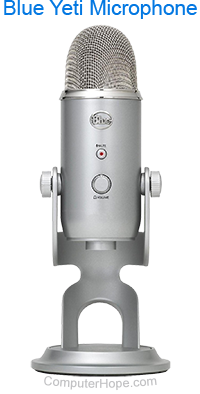Microphone

Sometimes abbreviated as mic, a microphone is a hardware peripheral and input device originally invented by Emile Berliner in 1877. A microphone allows computer users to input audio into their computers. Pictured here is a Blue Microphone's Yeti USB microphone - silver edition, an example of a high-quality computer microphone.
What is a microphone used for on a computer?
Below lists the most common uses for a microphone on a computer.
- Recording audio for a video.
- Voice recorder
- VoIP (Voice over Internet Protocol)
- Voice recognition
- Computer gaming
- Online chatting
- Capturing any noise in a room.
- Recording voice for dictation, singing, and podcasts.
- Recording musical instruments.
Where is the microphone plugged into a computer?
The microphone plugs into the computer sound card microphone port on the back of desktop computers. Some computer cases may also have a microphone port on the front.
On laptop computers, the microphone is plugged into the microphone port found on the front or side of the laptop.
More advanced microphones, like the Yeti microphone pictured above, connect to the computer using USB (universal serial bus).

The microphone port is usually marked with an icon of a microphone, as pictured. The port may also be labeled "mic." If the port connectors are color-coded, the pink connector is usually the microphone port. See our sound card page for further information about these ports for desktop computers. For a full listing of computer-related symbols, see: What are the most common symbols used by computers?
My Computer doesn't have a microphone jack
Some newer computers are no longer including a mic jack on a computer. For computers without a mic jack consider switching to a USB microphone or getting a USB sound card with a microphone jack.
What type of microphones are available?
Below are the most common types of microphones and how they are used.
Omnidirectional microphone
An omnidirectional microphone can pick up sound in all directions around the microphone. These microphones are used in studios to record more than one person or musical instrument. For example, the Yeti microphone shown at the top of this page is an example of an omnidirectional microphone.
Unidirectional microphone
A unidirectional microphone is any microphone that picks up sound in one direction. This type of microphone is helpful for when someone only wants to record one thing, such as their voice when doing a podcast or voice-over.
Bidirectional microphone
A bidirectional microphone is a microphone that picks up sound equally from the front and back of the microphone. This type of microphone is good to use when interviewing a person to pick up the interviewer and interviewee sound equally.
Close-talk microphone
A close-talk microphone is designed to have someone's mouth near the microphone without creating noise that may occur with other microphones. These microphones are used with a headset and phones, and are great for voice-recognition software.
Clip-on microphone
Also known as a lavalier microphone, a clip-on microphone is a hands-free wireless mic that clips to the user's shirt.
Why is a microphone considered an input device?
Because a microphone sends information to a computer, it's considered an input device. For example, when a microphone records a voice, the audio is sent to the computer and stored on the computer's hard drive. Once the recording is stored as an audio file, it can be played, edited, and shared.
Microphones are essential to voice recognition technology, which uses your voice to issue commands to the computer and execute specific tasks. Examples of this technology are digital assistants, like Cortana, Siri, and Google Assistant.
Accessory, Computer abbreviations, Hardware terms, Headset, Hot mic, Input device, Line in, Mini plug, Peripheral, Sound terms, Ventrilo, Voice recognition
